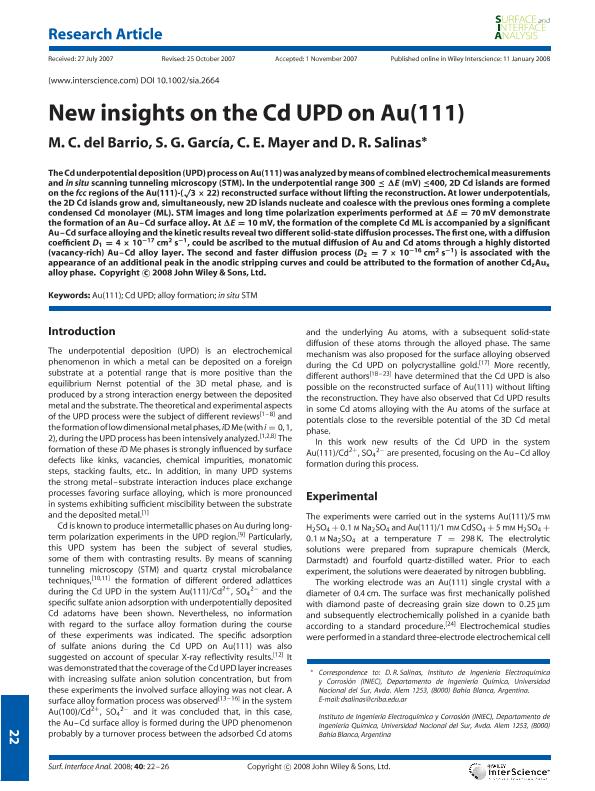Artículo
New insights on the Cd UPD on Au(111)
del Barrio, Maria Cecilia ; Garcia, Silvana Graciela; Mayer, Carlos Enrique; Salinas, Daniel Ricardo
; Garcia, Silvana Graciela; Mayer, Carlos Enrique; Salinas, Daniel Ricardo
 ; Garcia, Silvana Graciela; Mayer, Carlos Enrique; Salinas, Daniel Ricardo
; Garcia, Silvana Graciela; Mayer, Carlos Enrique; Salinas, Daniel Ricardo
Fecha de publicación:
11/01/2008
Editorial:
John Wiley & Sons Ltd
Revista:
Surface and Interface Analysis
ISSN:
0142-2421
e-ISSN:
1096-9918
Idioma:
Inglés
Tipo de recurso:
Artículo publicado
Clasificación temática:
Resumen
The Cd underpotential deposition (UPD) process on Au(111) was analyzed by means of combined electrochemical measurements and in situ scanning tunneling microscopy (STM). In the underpotential range 300 ≤ ΔE (mV) ≤400, 2D Cd islands are formed on the fcc regions of the Au(111)-(√3 × 22) reconstructed surface without lifting the reconstruction. At lower underpotentials, the 2D Cd islands grow and, simultaneously, new 2D islands nucleate and coalesce with the previous ones forming a complete condensed Cd monolayer (ML). STM images and long time polarization experiments performed at ΔE = 70 mV demonstrate the formation of an Au-Cd surface alloy. At ΔE = 10 mV, the formation of the complete Cd ML is accompanied by a significant Au-Cd surface alloying and the kinetic results reveal two different solid-state diffusion processes. The first one, with a diffusion coefficient D1 = 4 × 10-17 cm2 s -1, could be ascribed to the mutual diffusion of Au and Cd atoms through a highly distorted (vacancy-rich) Au-Cd alloy layer. The second and faster diffusion process (D2 = 7 × 10-16 cm2 s -1) is associated with the appearance of an additional peak in the anodic stripping curves and could be attributed to the formation of another CdzAux alloy phase.
Palabras clave:
Alloy Formation
,
Au(111)
,
Cd Upd
,
In Situ Stm
Archivos asociados
Licencia
Identificadores
Colecciones
Articulos(CCT - BAHIA BLANCA)
Articulos de CTRO.CIENTIFICO TECNOL.CONICET - BAHIA BLANCA
Articulos de CTRO.CIENTIFICO TECNOL.CONICET - BAHIA BLANCA
Citación
del Barrio, Maria Cecilia; Garcia, Silvana Graciela; Mayer, Carlos Enrique; Salinas, Daniel Ricardo; New insights on the Cd UPD on Au(111); John Wiley & Sons Ltd; Surface and Interface Analysis; 40; 1; 11-1-2008; 22-26
Compartir
Altmétricas



